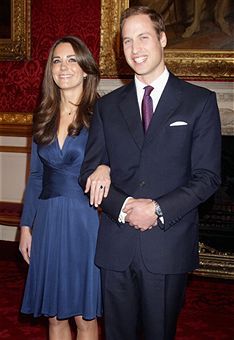 Now that we have a date in the diary, we can begin the traditional rites and customs on
the path to the Royal Wedding. These traditions stretch back to Queen Victoria – street parties, pageants, commemorative china, bunting and flags, and an almighty row about how much
it’s all costing.
Now that we have a date in the diary, we can begin the traditional rites and customs on
the path to the Royal Wedding. These traditions stretch back to Queen Victoria – street parties, pageants, commemorative china, bunting and flags, and an almighty row about how much
it’s all costing.
The cost of the monarchy is a perpetual controversy, given new impetus by any major monarchical occasion. Already, David Cameron’s decree that the date will be a public holiday is causing disquiet among some business leaders, who will lose a day’s trade. As Guido Fawkes points out, the additional day-off, coupled with Good Friday and Easter Monday, will make for a miserable year-end for many businesses. The CBI estimates that each additional bank holiday costs the UK economy £6 billion, although that doesn’t account for the extra trade for off-licences, and the added sales for manufacturers of paper hats, fireworks and big-screen televisions.
There has been an argument about the monarchy’s bill since its inception. On the one hand, those (not all republicans by any means) who say it costs too much; on the other, those that point to the additional revenues generated by tourism, which supposedly outweigh the Royals’ direct costs. Much of the argument is clouded by misunderstanding. The civil list, most of which pays for the royal household, is just one of six sources of income for the monarchy, as identified by Vernon Bognador. The other five are grants-in-aid (for the upkeep of buildings), the privy purse (to pay personal costs), direct expenditure by government departments, income from visitors to royal palaces, and the monarch’s personal investment income. This latter figure is confidential, as it would be for any other individual, but it is a safe bet to say it’s not peanuts.
At the time of the Glorious Revolution, parliament struck a deal to provide state funding for the upkeep of the monarchy. This became the first Civil List in 1697, and has been renewed for every monarch. A significant settlement took place in 1760 when Parliament seized control of revenues from the Crown Lands (excluding the Duchies of Lancaster and Cornwall), in return for a guaranteed civil list. This is now the Crown Estate, with a portfolio worth £6.6 billion, and profits this year of £210.7 million. It includes great tracts of agricultural land, Windsor Great Park, St James’s, parts of the West End, and just over half of Britain’s shoreline. There are some, the Prince of Wales for example, who argue that the Royal Family has done rather badly out of the deal struck in 1760. The value of the land is worth vastly more than the paltry amounts doled out by the politicians. The Prince argues that if the taxpayer object to funding the monarchy, the solution is simple: reverse the 1760 settlement. The argument, though reasonable, makes no financial sense. Britain would lose billions in tax revenue from the Crown Estate. As for the Royal Family seizing Regent Street, Pall Mall, a retail park in Slough, Chester Castle, Plymouth Hoe, part of Bluewater and swathes of farms, forests and beaches, it would in effect represent a new Norman Conquest.
So who should pay for the monarchy? Even the most blood-thirsty republicans, Roy Hattersley say, must accept that the Royals have remarkable sticking power. To understand their longevity, you have to understand that the only true royal tradition is re-invention. From the Conquest, through the Civil Wars, the rise of party politics, to the age of Hello! the monarchy has prospered. It has survived everything from Oliver Cromwell to Jennie Bond. With Prince William and Kate Middleton, we are witnessing a new phase of re-invention, which guarantees the monarchy a renewed lease of life. It’s a bit like Dr Who. Given that they’ll be with us for the foreseeable future, a new funding method is required. In the 1970s, Labour MP Douglas Houghton suggested turning the royal household into a government department, with proper parliamentary scrutiny. Proper scrutiny is needed, but not at the cost of turning royal flunkies into civil servants.
Instead, we might look at the German church tax as a model. Article 137 of the Weimar Constitution of 1919 and article 140 of the German Basic Law of 1949 provide for supporters of the church to raise and collect a tax to pay for the institutions and wages. If you don’t belong to the church, you are exempt. Most British taxpayers are monarchists; some are not. A voluntary tax, hypothecated for the monarchy, would be paid by most of Britain’s 30 million-plus income tax payers. If each paid an annual contribution of £5, the grant to the monarchy would be over £150 million. Those libertarians, revolutionaries, republicans and liberal democrats who complain about ‘their’ taxes being spent on palaces and princes would be silenced.
And what about one-off spectaculars such as the Windsor-Middleton nuptials? Look around London, or most other cities, to see the answer: public subscription. The Victorians built their libraries, museums and statues with funds raised voluntarily, either in return for a jolly good day out in the case of the Great Exhibition, or as a result of a public appeal. Taxpayers then (even Queen Victoria, who paid her taxes unlike some of her descendents) didn’t enter into it. Millions will enjoy the royal wedding – let them pay for it through a public subscription. The traditional pre-wedding anxiety about paying the bill would be avoided.
Paul Richards is a former special adviser to Hazel Blears





Comments